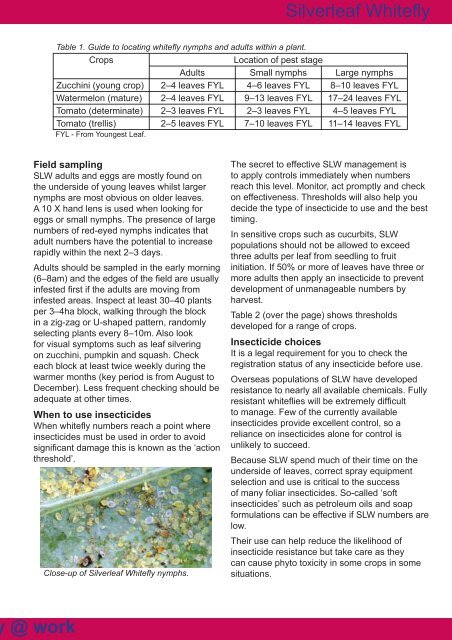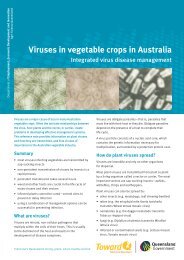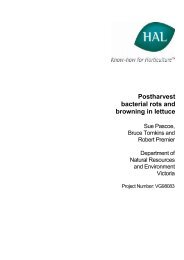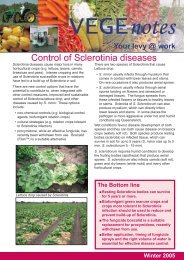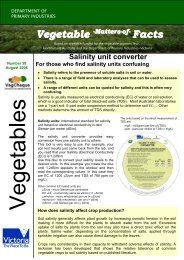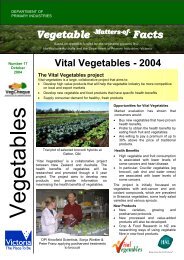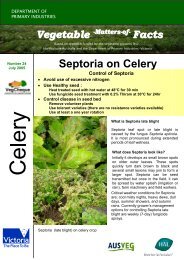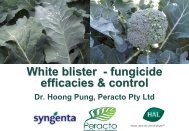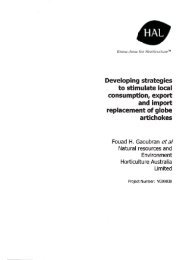Silverleaf Whitefly Management
Silverleaf Whitefly Management
Silverleaf Whitefly Management
- No tags were found...
Create successful ePaper yourself
Turn your PDF publications into a flip-book with our unique Google optimized e-Paper software.
<strong>Silverleaf</strong> <strong>Whitefly</strong>Table 1. Guide to locating whitefl y nymphs and adults within a plant.CropsLocation of pest stageAdults Small nymphs Large nymphsZucchini (young crop) 2–4 leaves FYL 4–6 leaves FYL 8–10 leaves FYLWatermelon (mature) 2–4 leaves FYL 9–13 leaves FYL 17–24 leaves FYLTomato (determinate) 2–3 leaves FYL 2–3 leaves FYL 4–5 leaves FYLTomato (trellis) 2–5 leaves FYL 7–10 leaves FYL 11–14 leaves FYLFYL - From Youngest Leaf.Field samplingSLW adults and eggs are mostly found onthe underside of young leaves whilst largernymphs are most obvious on older leaves.A 10 X hand lens is used when looking foreggs or small nymphs. The presence of largenumbers of red-eyed nymphs indicates thatadult numbers have the potential to increaserapidly within the next 2–3 days.Adults should be sampled in the early morning(6–8am) and the edges of the field are usuallyinfested first if the adults are moving frominfested areas. Inspect at least 30–40 plantsper 3–4ha block, walking through the blockin a zig-zag or U-shaped pattern, randomlyselecting plants every 8–10m. Also lookfor visual symptoms such as leaf silveringon zucchini, pumpkin and squash. Checkeach block at least twice weekly during thewarmer months (key period is from August toDecember). Less frequent checking should beadequate at other times.When to use insecticidesWhen whitefly numbers reach a point whereinsecticides must be used in order to avoidsignificant damage this is known as the ‘actionthreshold’.Close-up of <strong>Silverleaf</strong> Whitefl y nymphs.The secret to effective SLW management isto apply controls immediately when numbersreach this level. Monitor, act promptly and checkon effectiveness. Thresholds will also help youdecide the type of insecticide to use and the besttiming.In sensitive crops such as cucurbits, SLWpopulations should not be allowed to exceedthree adults per leaf from seedling to fruitinitiation. If 50% or more of leaves have three ormore adults then apply an insecticide to preventdevelopment of unmanageable numbers byharvest.Table 2 (over the page) shows thresholdsdeveloped for a range of crops.Insecticide choicesIt is a legal requirement for you to check theregistration status of any insecticide before use.Overseas populations of SLW have developedresistance to nearly all available chemicals. Fullyresistant whiteflies will be extremely diffi cultto manage. Few of the currently availableinsecticides provide excellent control, so areliance on insecticides alone for control isunlikely to succeed.Because SLW spend much of their time on theunderside of leaves, correct spray equipmentselection and use is critical to the successof many foliar insecticides. So-called ‘softinsecticides’ such as petroleum oils and soapformulations can be effective if SLW numbers arelow.Their use can help reduce the likelihood ofinsecticide resistance but take care as theycan cause phyto toxicity in some crops in somesituations.@ work


